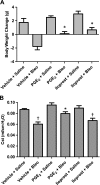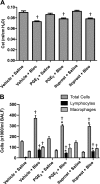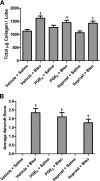Prostaglandin E₂ protects murine lungs from bleomycin-induced pulmonary fibrosis and lung dysfunction
- PMID: 21856819
- PMCID: PMC3213994
- DOI: 10.1152/ajplung.00176.2011
Prostaglandin E₂ protects murine lungs from bleomycin-induced pulmonary fibrosis and lung dysfunction
Abstract
Prostaglandin E(2) (PGE(2)) is a lipid mediator that is produced via the metabolism of arachidonic acid by cyclooxygenase enzymes. In the lung, PGE(2) acts as an anti-inflammatory factor and plays an important role in tissue repair processes. Although several studies have examined the role of PGE(2) in the pathogenesis of pulmonary fibrosis in rodents, results have generally been conflicting, and few studies have examined the therapeutic effects of PGE(2) on the accompanying lung dysfunction. In this study, an established model of pulmonary fibrosis was used in which 10-12-wk-old male C57BL/6 mice were administered a single dose (1.0 mg/kg) of bleomycin via oropharyngeal aspiration. To test the role of prostaglandins in this model, mice were dosed, via surgically implanted minipumps, with either vehicle, PGE(2) (1.32 μg/h), or the prostacyclin analog iloprost (0.33 μg/h) beginning 7 days before or 14 days after bleomycin administration. Endpoints assessed at 7 days after bleomycin administration included proinflammatory cytokine levels and measurement of cellular infiltration into the lung. Endpoints assessed at 21 days after bleomycin administration included lung function assessment via invasive (FlexiVent) analysis, cellular infiltration, lung collagen content, and semiquantitative histological analysis of the degree of lung fibrosis (Ashcroft method). Seven days after bleomycin administration, lymphocyte numbers and chemokine C-C motif ligand 2 expression were significantly lower in PGE(2)- and iloprost-treated animals compared with vehicle-treated controls (P < 0.05). When administered 7 days before bleomycin challenge, PGE(2) also protected against the decline in lung static compliance, lung fibrosis, and collagen production that is associated with 3 wk of bleomycin exposure. However, PGE(2) had no therapeutic effect on these parameters when administered 14 days after bleomycin challenge. In summary, PGE(2) prevented the decline in lung static compliance and protected against lung fibrosis when it was administered before bleomycin challenge but had no therapeutic effect when administered after bleomycin challenge.
Figures








References
-
- American Thoracic Society Idiopathic pulmonary fibrosis: diagnosis and treatment International consensus statement American Thoracic Society (ATS), and the European Respiratory Society (ERS). Am J Respir Crit Care Med 161: 646–664, 2000 - PubMed
-
- American Thoracic Society/European Respiratory Society American Thoracic Society/European Respiratory Society International Multidisciplinary Consensus Classification of the Idiopathic Interstitial Pneumonias. This joint statement of the American Thoracic Society (ATS), and the European Respiratory Society (ERS) was adopted by the ATS board of directors, June 2001 and by the ERS Executive Committee, June 2001. Am J Respir Crit Care Med 165: 277–304, 2002 - PubMed
-
- Baum BJ, Moss J, Breul SD, Berg RA, Crystal RG. Effect of cyclic AMP on the intracellular degradation of newly synthesized collagen. J Biol Chem 255: 2843–2847, 1980 - PubMed
Publication types
MeSH terms
Substances
Grants and funding
LinkOut - more resources
Full Text Sources
Other Literature Sources
Medical

